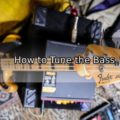Understanding musical notation is crucial for any bass guitar player. It opens up a world of musical possibilities and makes learning new songs easier. This guide will walk you through the basics of reading and understanding musical notation specifically for the bass guitar.
Why Learn Musical Notation?
Learning musical notation might seem daunting, but it offers numerous benefits. Not only does it enhance your ability to communicate with other musicians, but it also improves your overall musicality. Reading notation allows you to play a wider variety of music and helps you understand music theory better.
Improved Communication with Musicians
When you can read music, you can communicate more effectively with other musicians. It’s like speaking a common language. This skill is particularly useful in band settings where precise communication is key.
Helpful Hint:
Start by learning the basic notes on the bass guitar. This foundational knowledge will make reading notation much easier.
Enhanced Musical Skills
Understanding musical notation also improves your overall musicianship. It helps you develop a better sense of timing, rhythm, and harmony. Plus, it makes learning new songs faster and more efficient.
Stats:
According to a study by the National Association for Music Education, musicians who can read notation are 30% more likely to participate in advanced music ensembles.
Basics of Musical Notation
Before diving into the specifics for bass guitar, let’s cover some basic concepts of musical notation. These basics include the staff, clefs, notes, and rhythms.
Understanding Note Values for Bass Guitar
| Note | Symbol | Duration (in beats) | Description |
|---|---|---|---|
| Whole Note | ◉ | 4 beats | Lasts for a full measure in 4/4 time. |
| Half Note | ♪ | 2 beats | Half the duration of a whole note. |
| Quarter Note | ♫ | 1 beat | Commonly used, lasts for one beat. |
| Eighth Note | ♫ | 1/2 beat | Half a beat, used in faster passages. |
| Sixteenth Note | ♫ | 1/4 beat | Quarter of a beat, used in very fast passages. |
The Staff
The staff consists of five lines and four spaces. Each line and space represents a different musical pitch. Notes are placed on the staff to indicate which pitch to play.
Clefs
Clefs are symbols at the beginning of the staff that indicate the pitch of the notes. For bass guitar, the most common clef is the bass clef, also known as the F clef.
Notes and Rests
Notes represent the pitch and duration of a sound. Rests indicate silences. Understanding the different types of notes (whole, half, quarter, eighth, and sixteenth) and rests is crucial for reading music.
Time Signatures
Time signatures appear at the beginning of a piece of music, indicating the number of beats in each measure and the note value that gets the beat. Common time signatures include 4/4, 3/4, and 6/8.
Reading Bass Guitar Notation
Now that we’ve covered the basics, let’s focus on how to read musical notation specifically for bass guitar. This includes understanding the bass clef, note positions, and common rhythms used in bass music.
Understanding the Bass Clef
The bass clef, also known as the F clef, is used for lower-pitched instruments like the bass guitar. The two dots of the bass clef surround the F line on the staff, indicating where the note F is located.
Note Positions on the Bass Clef
On the bass clef, the lines from bottom to top represent the notes G, B, D, F, and A. The spaces represent the notes A, C, E, and G. Knowing these positions is key to reading bass guitar notation.
Helpful Hint:
Use mnemonics to remember note positions on the bass clef. For example, “Good Boys Do Fine Always” for the lines and “All Cows Eat Grass” for the spaces.
Common Rhythms in Bass Music
Bass music often features specific rhythms that are important to recognize. These include steady quarter notes, syncopated eighth notes, and complex sixteenth note patterns. Practicing these rhythms will improve your timing and groove.
Practical Tips for Learning Musical Notation
Here are some practical tips to help you get started with reading musical notation for the bass guitar. These tips will make the learning process smoother and more enjoyable.
Start Slow
Begin with simple songs and exercises. Don’t rush. Take your time to understand each note and rhythm. Gradually increase the difficulty as you become more comfortable.
Use Learning Resources
There are numerous resources available to help you learn musical notation. Books, online tutorials, and apps can provide structured learning paths and additional practice materials.
Practice Regularly
Consistency is key. Set aside regular practice time each day to work on reading music. Even 15-20 minutes a day can lead to significant improvement over time.
Stats:
Studies show that musicians who practice reading music regularly are 40% more likely to improve their sight-reading skills within six months.
Common Challenges and How to Overcome Them
Learning to read musical notation comes with its own set of challenges. Here are some common issues bass guitar players face and tips on how to overcome them.
Difficulty Recognizing Notes
One common challenge is quickly recognizing notes on the staff. To overcome this, practice note identification exercises. Flashcards and note recognition apps can be particularly helpful.
Struggling with Rhythm
Rhythmic accuracy is another common issue. Use a metronome to practice keeping a steady beat. Start with slow tempos and gradually increase the speed as you become more confident.
Integration with Bass Guitar Playing
Combining reading notation with playing the bass guitar can be tricky. Break down the process. Practice clapping rhythms and identifying notes separately before integrating them with your playing.
Benefits and Drawbacks of Learning Musical Notation for Bass Guitar
Pros
- Enhances musical communication skills.
- Improves overall musicianship.
- Allows access to a wider variety of music.
- Facilitates faster learning of new songs.
- Provides a deeper understanding of music theory.
Cons
- Initial learning curve can be steep.
- Requires consistent practice and dedication.
- May be challenging to integrate with playing initially.
- Can be time-consuming to master.
- Some players may prefer learning by ear.
FAQs
Wrapping Up
Understanding musical notation for bass guitar players is a valuable skill that enhances your musical abilities and opens up new opportunities. By starting with the basics and practicing regularly, you can master this skill and become a more versatile musician. Remember, learning musical notation is a journey that requires patience and persistence, but the rewards are well worth the effort. Happy playing!



